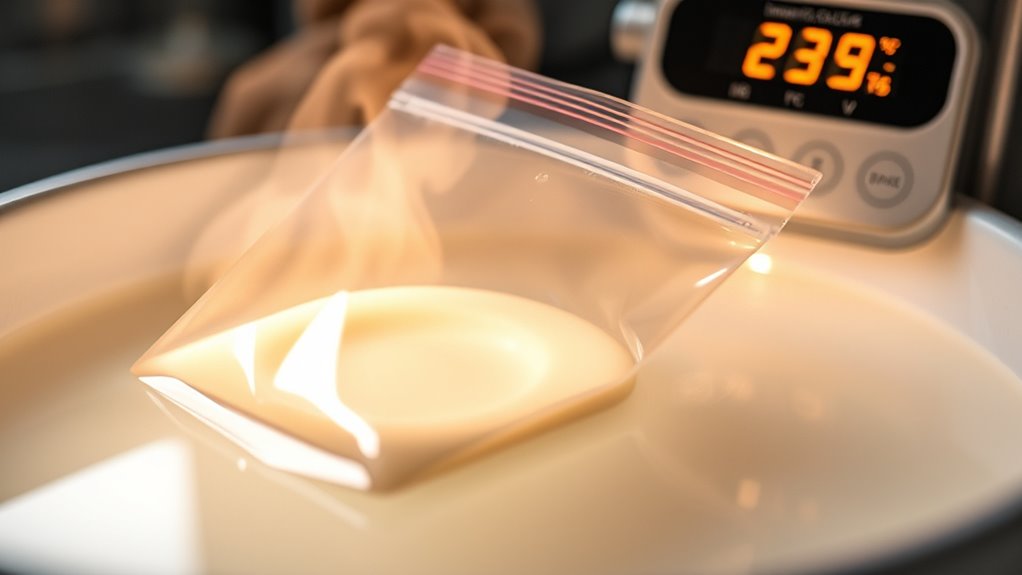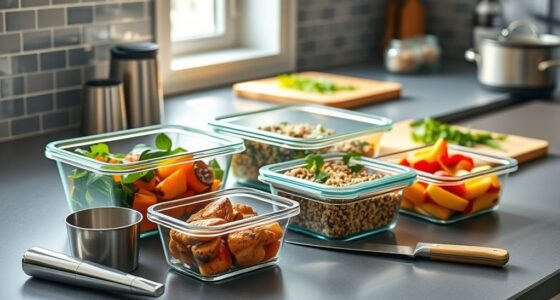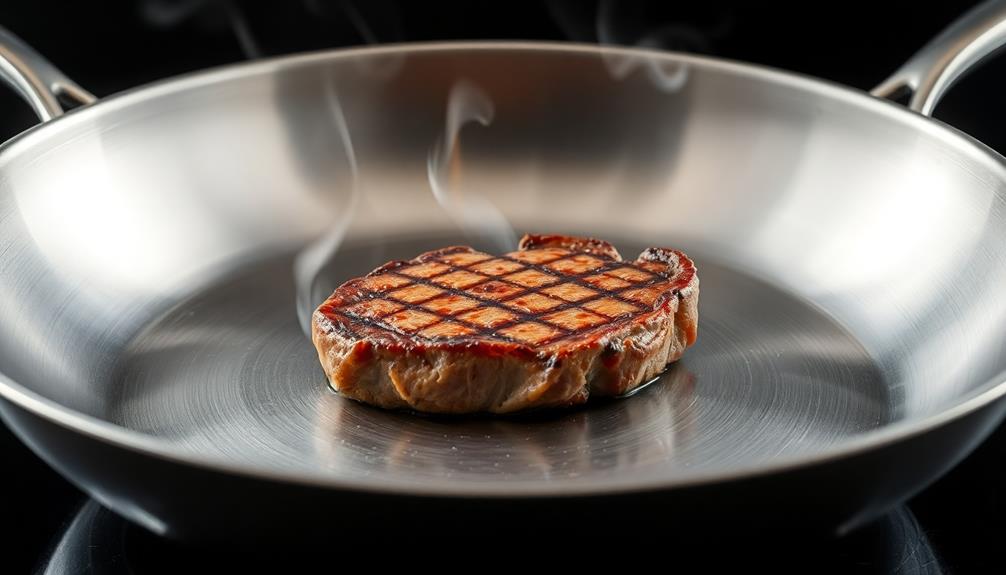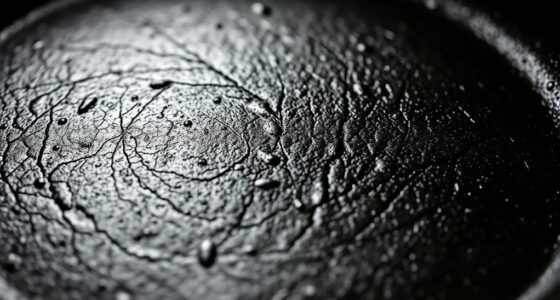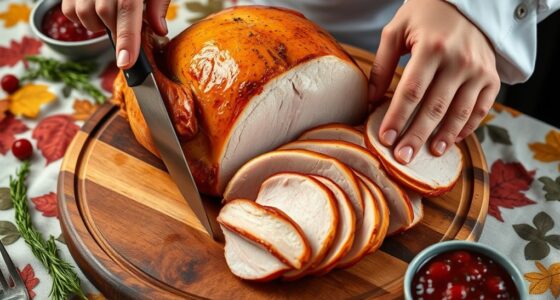To sous-vide custard safely and avoid Salmonella, set your water bath to 176°F (80°C) and cook it for 45 minutes to an hour. This temperature kills bacteria while keeping the custard smooth. Make sure the sealed container is fully submerged and maintain a stable temperature. After cooking, chill the custard quickly and store it properly. Want more tips on perfecting your sous-vide custard safely? Keep exploring for detailed guidance.
Key Takeaways
- Use pasteurized eggs or thoroughly whisk fresh eggs and strain to remove chalazae and shell fragments.
- Set sous-vide water bath to 176°F (80°C) and ensure it maintains this temperature consistently.
- Submerge the sealed custard container fully in water and monitor temperature with a reliable thermometer.
- Cook for at least 45 minutes, ensuring the custard reaches at least 176°F for 15 seconds to kill Salmonella.
- Rapidly chill the custard in an ice bath after cooking and store refrigerated until serving.
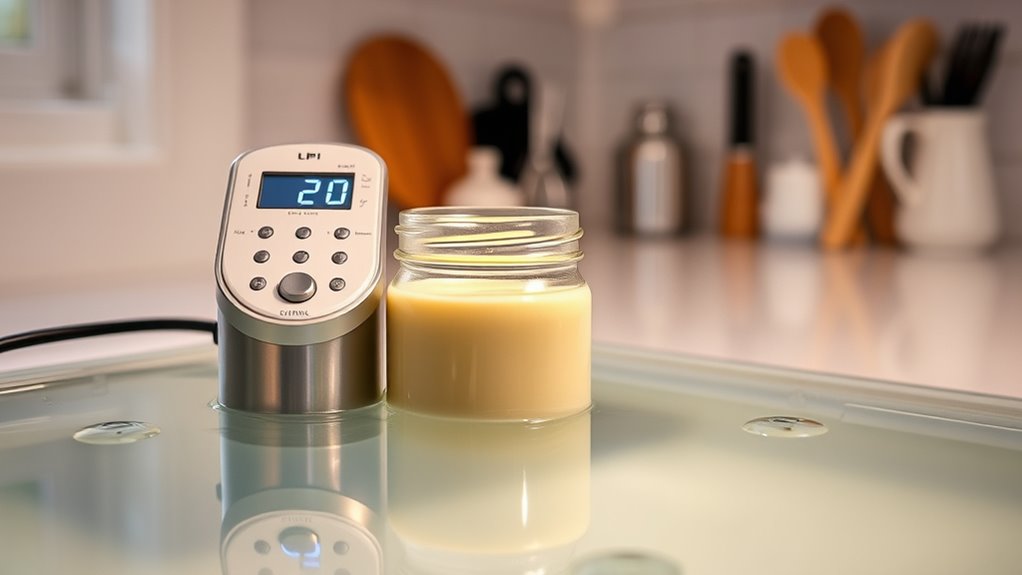
Sous-vide custard offers a foolproof way to achieve a silky, perfectly cooked dessert with minimal effort. When it comes to preparing custard safely, especially with eggs, understanding egg safety is essential. Raw eggs can harbor Salmonella, a bacteria that causes foodborne illness. To enjoy your custard without risking health issues, you need to follow precise cooking techniques that guarantee eggs reach a safe temperature. The key is to heat the custard gently and evenly, reducing the chance of undercooked spots where bacteria might survive.
Start by selecting fresh, high-quality eggs, and if possible, opt for pasteurized eggs, which have been heat-treated to eliminate bacteria without cooking the eggs fully. When preparing your custard mixture, whisk the eggs thoroughly with your other ingredients, then strain the mixture to remove any chalazae or shell fragments. This step guarantees a smooth texture and reduces contamination risk. Additionally, using proper food handling techniques can further minimize any health concerns.
The core of safe custard preparation with sous-vide lies in your cooking techniques. Set your sous-vide water bath to 176°F (80°C). This temperature is high enough to kill Salmonella while still maintaining the delicate texture of custard. Once your water bath reaches the target temperature, place your sealed custard bag or jar into the water, ensuring it’s fully submerged and water can circulate freely around it. This method guarantees even heat distribution, preventing hot spots or undercooked areas that might compromise egg safety. Proper temperature control is essential to achieve safe and consistent results. Additionally, understanding that the process involves precise temperature control ensures the eggs are cooked safely without overcooking. Incorporating temperature monitoring with a reliable thermometer can help you verify that the custard reaches and maintains the necessary temperature for safety.
Cooking times are equally important. Typically, a custard needs about 45 minutes to an hour in the water bath. During this period, the temperature remains stable, gently cooking the eggs to a safe, custard-like consistency. Use a thermometer to double-check that the custard reaches and stays at the target temperature for at least 15 seconds, which is recommended to eliminate Salmonella. After cooking, chill the custard rapidly in an ice bath before serving, further preventing bacterial growth.
Frequently Asked Questions
Can Sous-Vide Custard Be Made Dairy-Free?
You can definitely make sous-vide custard dairy-free by exploring dairy-free options like coconut milk or almond milk. To thicken it, use plant-based thickeners such as cornstarch, arrowroot, or agar-agar. These alternatives help achieve a creamy texture without dairy. Just make certain your ingredients are well-balanced, and cook at the right temperature to get a smooth, delicious dairy-free custard that’s safe and tasty.
What’s the Best Temperature to Prevent Overcooking?
When it comes to sous-vide custard, getting the temperature right is key—you don’t want to throw the baby out with the bathwater. To prevent overcooking and ensure silky texture, keep the water temperature around 176°F (80°C). This precise temperature regulation helps you avoid overcooking while fully cooking the custard. Stick to this sweet spot, and you’ll achieve perfect results without risking a watery or rubbery finish.
How Long Can Sous-Vide Custard Be Stored Safely?
You can store sous-vide custard safely in the refrigerator for up to 2 to 3 days. To guarantee refrigeration safety, keep it in an airtight container at or below 40°F (4°C). Avoid leaving it out at room temperature, as bacteria can grow quickly. For best quality and safety, consume the custard promptly within this storage duration, and reheat thoroughly before serving.
Is There a Way to Thicken Custard Without Eggs?
If you want to thicken custard without eggs, explore alternative thickening options and egg substitutes. You can use cornstarch, tapioca starch, or arrowroot powder, which each add richness and texture. Coconut milk or blended silken tofu also serve as creamy, egg-free alternatives. These options allow you to achieve a smooth, velvety custard without relying on eggs, making your dessert suitable for dietary restrictions or allergies.
Can I Reuse Sous-Vide Bags for Custard?
You can reuse sous-vide bags for custard, but focus on food safety. Always wash bags thoroughly with hot, soapy water and sanitize them to prevent bacteria transfer. Check bags for tears or damage before reuse, as compromised bags can harbor bacteria. Proper cleaning and inspection ensure safe bag reuse, reducing risks associated with food safety and bacteria. When in doubt, consider using new bags to keep your custard safe and delicious.
Conclusion
By carefully controlling your sous-vide water bath, you’re steering clear of the lurking iceberg of salmonella, ensuring your custard is both silky and safe. Think of it as tending a delicate garden—you nurture it gently, trusting the warmth to do its work without rushing. When you master this method, you’re not just making custard; you’re orchestrating a symphony of safety and flavor that delights every spoonful. Enjoy your perfectly cooked, worry-free treat!
